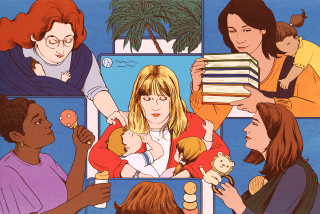Researchers Say Ads Miss Moms
CHICAGO — Marketers take note: If your ads depict mom in the kitchen slaving over a hot stove or racing to soccer practice in the station wagon, you’re way off target.
A new survey of mothers finds that advertising depicting women in traditional roles isn’t reflective of the lives most mothers lead today.
“There are a handful of cliches that are used in nearly all ads targeting mothers,” said Denise Fedewa, team leader on the study from Leo Burnett Co., of Chicago. “From the soccer mom to the germ-a-phobe, advertisers are employing obsolete ideals of what motherhood is all about. The moms in most ads don’t exist anymore.”
High priorities for today’s moms include the family eating together, building close relationships with children, expanding kids’ horizons and raising kids with good values, the study found.
Low priorities include cooking from scratch, keeping a tidy home, making sure kids are well-dressed and limiting kids’ consumption of junk foods, moms in the study said.
“Motherhood is a very complex and complicated topic. All of us have a mother in our lives somewhere. We have to keep in mind that no matter how that mother does it, it’s not the norm,” Fedewa said.
The study identified four types of mothers, each with distinct styles and views of motherhood, and each representing about 25% of the population of mothers:
* “June Cleaver: The Sequel” is the traditional, stay-at-home mom who exists to care for and nurture her family.
* The “Tug-of-War” mom is torn between the desire to be a traditional mom and the economic demands of providing income for her family.
* The “Strong Shoulders” mom does most of the parenting on her own with little involvement from the father; these moms tend to be resourceful and stress learning and self-esteem in their children.
* “Mothers of Invention” enjoy a strong sense of balance between work and family, generally viewing dad as an equal parenting partner.
Of the four categories, the study identified the “Strong Shoulders” and “Mothers of Invention” groups as growth segments, predicting that more women will join those groups, either out of necessity or aspiration.
Given the diversity of views of motherhood within these groups, Fedewa said advertisers will need to make some hard choices in deciding which segments of mothers to target. If a company has a large budget, it might opt to create ads for each distinct group, she said.
For smaller companies, she suggests looking at the history of the brand and evaluating where future growth might come from.
When in doubt, Fedewa suggests opting for the growth segments. “If you’re a leadership brand or in decline and you want to invigorate it, it’s important to portray the growing segments,” she said.
While there are no absolutes in marketing to moms, most of those interviewed responded positively to ads that presented authentic human relationships.
“Women by nature are very complex. Stories that interest them are things that have human complexity to them,” Fedewa said. “Advertisers are shortchanging them by reducing them to cliches. What women respond to is complexity of the issue and the humanness of it.”
To arrive at its findings, LeoShe, a group of Burnett executives who study trends pertaining to women, interviewed 403 mothers, including statistically significant numbers of Caucasian, black and Latino women. The interviews were conducted in informal settings, such as women’s homes, and included groups of friends.
LeoShe intends to present its findings to clients with products targeted at mothers. Burnett produces mom-targeted ads for a number of companies, including Kellogg Co., Walt Disney Co., Kraft Foods, McDonald’s Corp. and Procter & Gamble Co.






